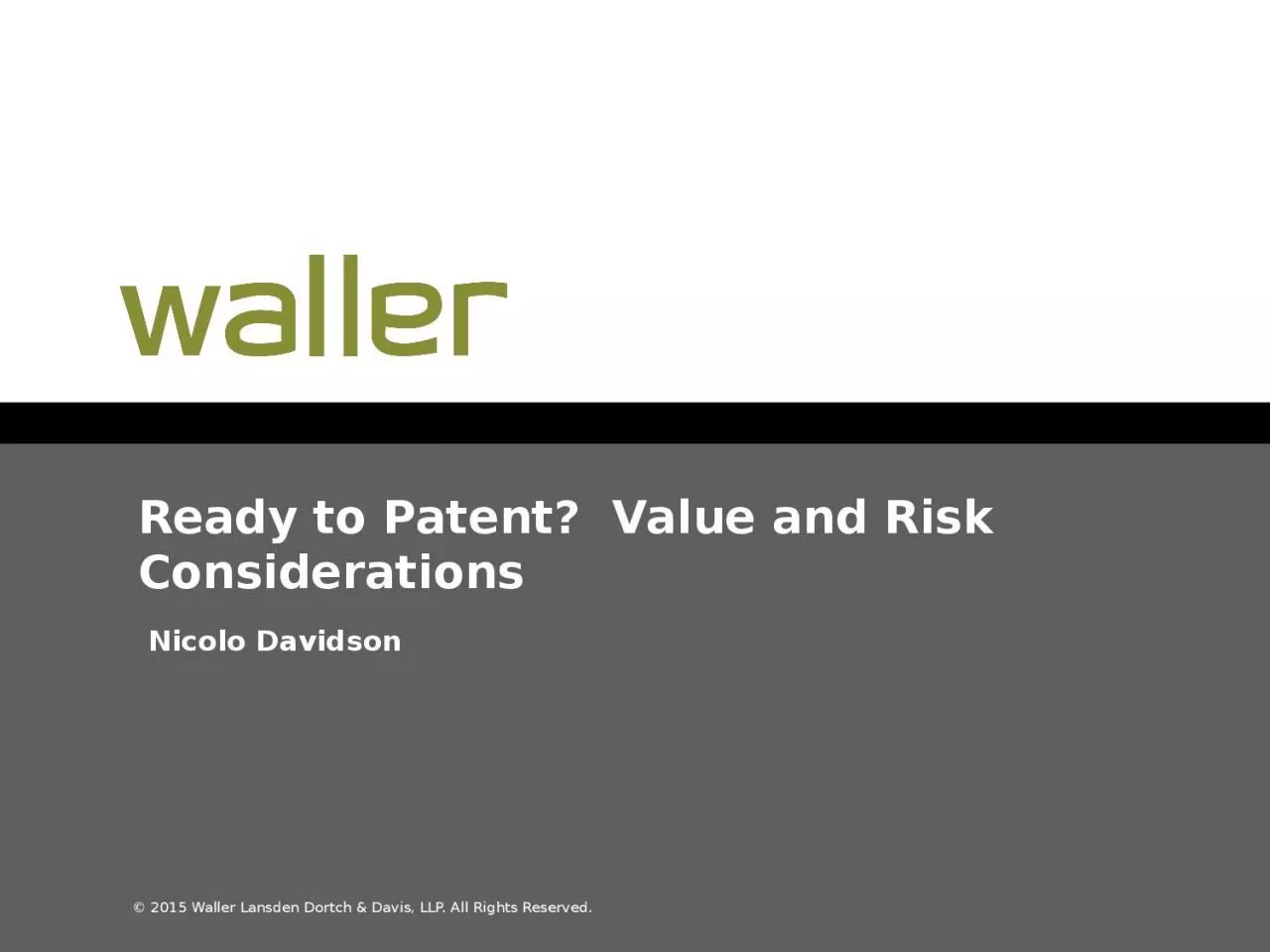

Nicolo Davidson Forbes 2014 Baby Patting Machine US Patent No 3552388 Portable Automobile Partition US Patent No 6260903 Valuation Market Freedom t o Operate Risks Scope ID: 1003149
Download Presentation The PPT/PDF document "Ready to Patent? Value and Risk Conside..." is the property of its rightful owner. Permission is granted to download and print the materials on this web site for personal, non-commercial use only, and to display it on your personal computer provided you do not modify the materials and that you retain all copyright notices contained in the materials. By downloading content from our website, you accept the terms of this agreement.
1. Ready to Patent? Value and Risk Considerations Nicolo Davidson
2.
3. * Forbes, 2014
4. Baby Patting MachineU.S. Patent No. 3,552,388
5. Portable Automobile PartitionU.S. Patent No. 6,260,903
6. ValuationMarketFreedom to Operate(Risks)Scope
7. ScopeClaims define protected inventionClaims are amended during prosecution to overcome prior disclosures (prior art)Continuation applications can seek broader claims
8. ScopeClaims must be described in applicationTClaimsCLAIMSSPECIFICATION
9. MarketWhat is the market?How big is the market?Is market growing?How long will it take to enter the market?Scale upRegulatory
10. MarketHow much of the market do you expect to control?Limited to certain segments?Geographical limitations?Do you have freedom to operate?Who are your competitors?Barriers to entry?IP or other exclusive rights?
11. Freedom to OperateInvention A Invention BComponent A Component A Component BPatent filed for Invention A before Invention BIs Invention B patentable over Invention A?Can one practice Invention B?
12. Freedom to Operate – PatentabilityClaim ComparisonInvention A. A composition for treating a fever, comprising: 70% - 90% of Component A; and 10% - 30% of Component B.Invention B. A composition for treating a fever, comprising: 50% - 80% of Component A; and 20% - 50% of Component B.
13. Freedom to Operate – PatentabilityDifferent limitationsInvention A. A composition for treating a fever, comprising: 70% - 90% of Component A; and 10% - 30% of Component B.Invention B. A composition for treating a fever, comprising: 50% - 80% 65% of Component A; and 20% 35% - 50% of Component B.
14. Freedom to OperatePatentability – New UseDiscovery of unappreciated (inherent) propertyNOT PATENTABLEInherent property must necessarily flow from prior artProperty need not be appreciated in prior art“Products of identical chemical composition can not have mutually exclusive properties.” In re Spada (Fed. Cir. 1990).New use for old compound may be patentable
15. Freedom to OperatePatentability – New UsePrior patent - Method of treating anxiety by use of fluoxetine hydrochlorideNew use patent - Method of blocking serotonin uptake by use of fluoxetine hydrochlorideNew use held to be inherent in first patented useNew “use” = result of same structure/compoundEli Lilly & Co. v. Barr Laboratories, Inc . (Fed. Cir. 2001)
16. Freedom to OperatePatentability – New UseJansen patent – Method of treating or preventing macrocytic-megaloblastic anemia [MMA] by administering folic acid and vitamin B12 to a human in need thereof (i.e., recognized need)Rexall – Folic acid and vitamin B12 for maintenance of proper blood homocysteine levelsNew use held not to infringe JansenMethod performed for different intended purposeNew “use” = unexpected new propertyJansen v. Rexall Sundown (Fed. Cir. 2003)
17. Freedom to OperateInfringement35 USC 271(a) - . . . whoever without authority makes, uses, offers to sell, or sells any patented invention, within the [US] or imports into the [US] any patented invention during the term of the patent therefor, infringes the patent.35 USC 271(e)(1) - It shall not be an act of infringement to make, use, offer to sell, or sell … a patented invention . . . solely for uses reasonably related to the development and submission of information under a Federal law which regulates the manufacture, use, or sale of drugs or veterinary biological products.
18. Freedom to OperateNew use, formulation, or delivery of patented for composition of matterNew use of composition not under patentNew delivery / formulation of composition not under patentNo patent = lack of exclusivityOrphan Drug (<200K patients) – 7New Chemical Entity – 5 years“Other” – 3 years (e.g., new studies for new use)
19. Freedom to OperateNew use, formulation, or delivery of patented for composition of matter INFRINGEAnyone who “makes, uses, offers to sell, or sells” composition of matter is liable for infringementRequires permission (i.e., license) from patent ownerCostlyLittle incentive
20. Freedom to OperateNew use of composition not under patent NO INFRINGEMENTMay be patentableAre you protected from off-label use?Weak pricing powerWho is infringing? Who will you enforce against?Is new use patentable or is it inherent?
21. Freedom to OperateNew delivery / formulation of composition not under patent NO INFRINGEMENT; may be patentableHigh bar to patentabilityDrug repurposing is crowded fieldKSR v. Teleflex (2007) – “obvious to try”New combinations?Look for superior and unexpected results
22. Freedom to OperateNew uses or formulations often are done by the same company
23. Bringing it TogetherPatent scope can define your exclusive rightsMust consider market to see how you can monetize your exclusive rightsWithout freedom to operate, there is no market
24. Nicolo DavidsonWaller Lansden Dortch & Davis, LLPNashville, TN nicolo.davidson@wallerlaw.com615.850.8464